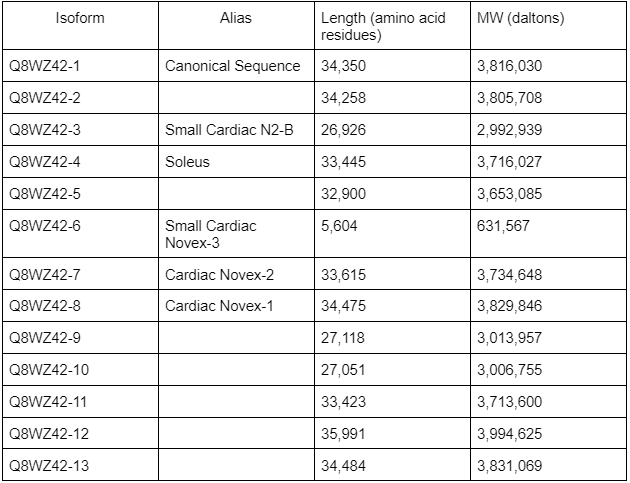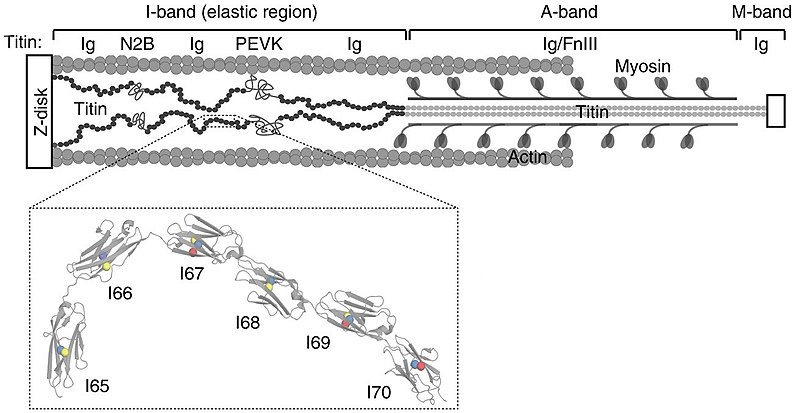Titin related diseases
From Proteopedia
Titin
IntroductionTitin, which is also known as connectin, is the largest known protein at over 1 µm in length, a molar mass of 3.816 million Daltons, and 34,350 amino acid residues. In humans it is encoded for by the TTN gene. The protein family is responsible for passive elasticity of muscle, acting as a molecular spring. StructureTitin is a very large protein, comprising 244 individually folded protein domains which are connected via unstructured peptide sequences. Its structure is significant within the sarcomere, as it spans half of the unit, connecting the Z line to the M line, contributing to force transmission and resting tension at the Z line and I band respectively. The protein titin has thirteen different isoforms in human striated muscle tissues, due to alternative splicing. The canonical sequence is isoform Q8WZ42-1, which was described above in the introduction. All thirteen isoforms are between ~27,000 and ~36,000 amino acid residues in length, except for the small cardiac novex-3, or Q8WZ42-6 isoform; which is ~5600 residues in length. Titin's empirical chemical formula is C₁₆₉₇₁₉H₂₇₀₄₆₆N₄₅₆₈₈O₅₂₂₃₈S₉₁₁, and has an in-vivo half-life of 30 hours. The titin protein is found in muscle tissue, and is located between the myosin thick filament and Z disc of a sarcomere. It consists primarily of a linear array of 244 copies of two protein domains. These domains are type I fibronectin type III domain (Fn3)(132 copies) and type II immunoglobulin domain (Ig)(112 copies). The protein is further organized into two regions: the N-terminal I-band, and C-terminal A-band. The N-terminal I-band is the elastic region, composed largely of type II immunoglobulin domains. Containing two regions of type II immunoglobulin domains on either side of a PEVK region: containing a large concentration of proline, glutamate, valine and lysine. There are also super repeat segments of differentially expressed Ig domains. This region exhibits both entropic and enthalpic elasticity, and is characterized by a persistent length, and stretch modulus. This elasticity can be modeled with a worm-like chain model of entropic elasticity. The N-terminal also contains a Z repeat at the Z-disc end, which recognizes Actinin alpha 2. The C-terminal A-band is composed of alternating type I Fn3, and type II Ig domains, also with super repeat segments. These segments align with corresponding repeats of the myosin thick filaments; with the immunoglobulin domains matching with the myosin crowns. The C-terminal contains a serine kinase domain as well, situated on the end, it aids in adapting muscle to mechanical strain through the repair of overstretching in the sarcomere. This structure of titin is present across many species, though differences across them are especially apparent among the PEVK motifs, which trend towards an increase throughout evolutionary history. FunctionTitin plays a major role in the assembly and function of muscle sarcomeres,[2] and as so is very abundant in striated muscle. One of its most important functions is to provide elasticity to sarcomeres, specifically stabilizing the myosin thick filament. It accomplishes this due to its ability to increase in length under applied force, only to shorten back to its original length when no longer under the stress. The mechanism of this is multiphase, with the hierarchical unfolding of the polypeptide following small systemic changes under applied force. The protein has a tendency to coil up in the absence of applied extensional force, and then straighten when under a small extensional force is applied. The N-terminal Z disc region and C-terminal M-line regions of titin bind to their respective Z and M-lines of the sarcomere. This makes it so that a single titin molecule must span half the length of the sarcomere. Titin also serves as an adhesion template for muscle associated proteins, due to its binding sites that correspond with myosin, as written previously in the structure section. Different isoforms[3] of titin can also play a role in impacting the function of the protein. In order to modulate passive resistance in cardiomyocytes, the isoform small cardiac N2-B is predominant. Since N2-B is significantly shorter in length and fewer exons expressed from the I-band, it has less Ig domains, and therefore has less elasticity. DiseaseFlaws in the protein titin have been related to multiple medical conditions and diseases. For instance, there is a dominant mutation in the TTN gene, which encodes for titin which results in the subject being predisposed to hernias.[4] Inguinal hernias occur in the groin, between the lower abdomen and thigh, when part of the membrane lining of intestine protrudes through a weak spot in the abdomen, generally along the inguinal canal. Through whole exome sequencing, family lines in Estonia with high prevalence of inguinal hernias were found to be correlated with a heterozygous missense mutation. The mutation, c.88880A>C, is in the TTN gene located in exon 339 leads to a change from a positively charged lysine to an uncharged threonine in the myosin binding A-band segment of the titin protein. This missense leads to potentially disrupted interactions between titin and titin binding proteins, and even the misfolding of the protein itself. This gives a potential explanation for the noted pattern of familial inheritance of risk of inguinal hernia. Changes to the protein Titin also have also been linked to cardiomyopathy.[5] Dilated cardiomyopathy (DCM) is a leading cause of heart failure, heart transplant, and sudden cardiac death. It occurs as a disease of the heart muscle, generally occurring in the left ventricle, which stretches and thins. This results in an inability to pump blood as effectively. DCM can be genetic, and is the result of inheritance in approximately fifty percent of cases. The most frequent mode of inheritance of cardiomyopathy is the result of passing down a defective variant of the TTN gene that results in the truncation of the titin protein. These titin truncation defects may lead to haploinsufficiency and loss of function. When TTN truncation variants (TTNtvs) affect exons expressed on cardiac tissue, it contributes to a PSI score, which is used to predict the likelihood of DCM in a subject. PSI calculates a percentage of titin transcripts in which a given exon is spliced into an expressed transcript based upon RNA sequencing data taken from tissue from the heart's left ventricle. This can be read as a high PSI score dictating a high proportion of transcripts of the exon being expressed in heart tissue, and a low PSI score dictating a low proportion of transcripts of that exon being expressed in heart tissue. Titin truncation variants located in exons with PSI > 0.9 have been correlated to as high as a 93% probability of pathogenicity in subjects possessing a DCM phenotype. The exact mechanism of how titin truncation variants lead to the DCM phenotype has yet to be completely identified. In genetic lineages with inherited TTNtvs, the heritability follows an autosomal dominant pattern. However, there is also an age-dependent factor in penetrance, as subjects may carry the predicted pathogenic titin truncation variant, but do not develop DCM until later in life.[6] In patients with DCM, the enlargement of the ventricles leads to a decreased systolic function, with decreased passive tension; a direct failure of titin's role in the cardiac tissue. Patients with DCM had an increased ratio of N2-BA:N2-B, noting a change in that a normal healthy heart typically has more N2-B titin isoform. The N2-B isoform is shorter, and has less elasticity than the longer N2-BA isoform, which possesses more Ig domains in its I-band. This can occur due to alternative splicing of RNA during transcription, as a result of the spliceosome covalently binding to form a stable RNA molecule. The change in N2-BA:N2-B titin ratio leads to stiffening of titin and a more rigid sarcomere. The more rigid sarcomere may then lead to imparired relaxation in the ventricle, as seen with preserved ejection fraction. As such the ratio of N2-BA:N2-B titin expression to control titin stiffness is significant as a potential therapeutic target for patients with systolic and diastolic dysfunction. ReferencesFranaszczyk, M., Chmielewski, P., Truszkowska, G., Stawinski, P., Michalak, E., Rydzanicz, M., Sobieszczanska-Malek, M., Pollak, A., Szczygieł, J., Kosinska, J., Parulski, A., Stoklosa, T., Tarnowska, A., Machnicki, M. M., Foss-Nieradko, B., Szperl, M., Sioma, A., Kusmierczyk, M., Grzybowski, J., … Bilinska, Z. T. (2017, January 3). Titin truncating variants in dilated cardiomyopathy - prevalence and genotype-phenotype correlations. PloS one. Retrieved April 28, 2022, from https://www.ncbi.nlm.nih.gov/pmc/articles/PMC5207678/ Giganti, D., Yan, K., Badilla, C. L., Fernandez, J. M., & Alegre-Cebollada, J. (2018, January 12). Disulfide isomerization reactions in titin immunoglobulin domains enable a mode of protein elasticity. Nature News. Retrieved April 28, 2022, from https://www.nature.com/articles/s41467-017-02528-7 Lahmers, S., Sunshine Lahmers From the Departments of Veterinary and Comparative Anatomy, Wu, Y., Yiming Wu From the Departments of Veterinary and Comparative Anatomy, Call, D. R., Douglas R. Call From the Departments of Veterinary and Comparative Anatomy, Labeit, S., Siegfried Labeit From the Departments of Veterinary and Comparative Anatomy, Granzier, H., Henk Granzier From the Departments of Veterinary and Comparative Anatomy, & Granzier, C. to H. L. (2004, January 5). Developmental control of titin isoform expression and passive stiffness in fetal and neonatal myocardium. Circulation Research. Retrieved April 28, 2022, from https://www.ahajournals.org/doi/10.1161/01.res.0000115522.52554.86 Mihailov, E., Nikopensius, T., Reigo, A., Nikkolo, C., Kals, M., Aruaas, K., Milani, L., Seepter, H., & Metspalu, A. (2017, February). Whole-exome sequencing identifies a potential TTN mutation in a multiplex family with inguinal hernia. Hernia : the journal of hernias and abdominal wall surgery. Retrieved April 28, 2022, from https://www.ncbi.nlm.nih.gov/pmc/articles/PMC5281683/ Tharp, C. A., Haywood, M. E., Sbaizero, O., Taylor, M. R. G., & Mestroni, L. (2019, November 28). The giant protein titin's role in cardiomyopathy: Genetic, transcriptional, and post-translational modifications of Ttn and their contribution to cardiac disease. Frontiers in physiology. Retrieved April 28, 2022, from https://www.ncbi.nlm.nih.gov/pmc/articles/PMC6892752/ Tskhovrebova, L., & Trinick, J. (2010). Roles of titin in the structure and elasticity of the sarcomere. Journal of biomedicine & biotechnology. Retrieved April 28, 2022, from https://.ncbi.nlm.gov/pmc/articles/PMC2896707/ | ||||||||||||


